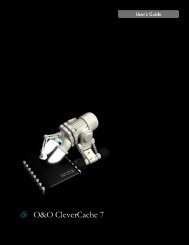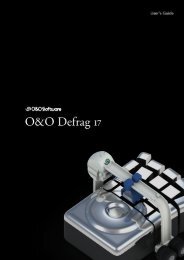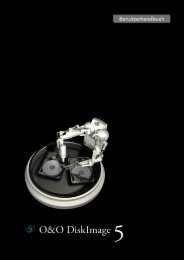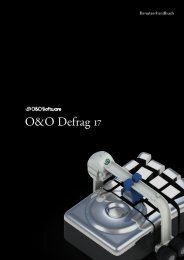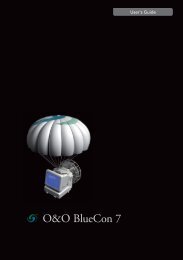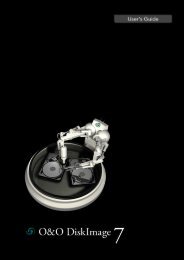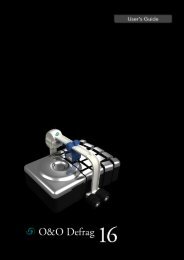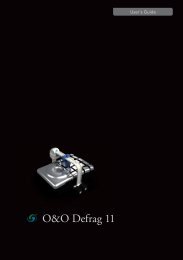O&O Defrag 15 User's Guide - O&O Software
O&O Defrag 15 User's Guide - O&O Software
O&O Defrag 15 User's Guide - O&O Software
Create successful ePaper yourself
Turn your PDF publications into a flip-book with our unique Google optimized e-Paper software.
Technical information<br />
Technical information<br />
The following technical information will be helpful when applying O&O <strong>Defrag</strong>:<br />
Conflicts with shadow copies during defragmentation<br />
The operating systems Windows 7, Windows Vista, Windows XP64, Windows Server 2003 and 2008 offer users the<br />
ability to create "Shadow Copies" for protecting their data. This new feature automatically creates copies of files<br />
currently in use at regular time intervals. Since Windows only captures changes in the files, additional space is normally<br />
not needed. Accidentally deleted files and folders or previous versions of documents can be easily restored<br />
using a convenient command accessible through the right-click menu. Simply right-click the object you want to<br />
restore and click "Restore Previous Versions".<br />
At the moment of installation, Windows Vista and Windows 7 the shadow copy mechanism is set by default. With<br />
Windows XP64 and Windows Server 2003/2008 systems it is disabled by default.<br />
During defragmentation, files on a volume get moved. Windows classifies these operations as a deletion and therefore<br />
creates a complete new shadow copy of the moved file. Since a lot of files are moved during a defragmentation,<br />
a lot of new entries are created in the shadow copies and they take up more space on your data volume<br />
than before the defragmentation. This behavior may overwrite older shadow copies with newer ones. Unfortunately,<br />
this can also lead to the deletion of the system recovery points! These consequences are most frequent<br />
when using the COMPLETE method.<br />
Shadow copies are filed in the folder “System Volume Information” and cannot be defragmented. This can end up<br />
having a negative influence on the results of the defragmentation. There is, on the other hand, almost hardly any<br />
loss in performance caused by fragmented shadow copies. Although these files will be displayed as fragmented,<br />
they still have only a minimal influence on the operating speed of your system.<br />
You could disable the shadow copies to achieve improved defragmentation results but you would then wind up losing<br />
the operating system’s built-in backup functionality. That’s why we recommend your leaving the shadow copies<br />
enabled.<br />
Microsoft is already aware of this problem, as this issue also occurs in the Windows native defragmentation software.<br />
More details may be found in this article from Microsoft: http://support.microsoft.com/default.aspx?kbid=312067<br />
In Windows XP64 and Windows 2003 Server, this problem will not occur as long as storage volumes have been formatted<br />
with a cluster size of 16KB or larger.<br />
Notes concerning the default enabled automatic optimization:<br />
Please bear in mind that under Windows 7, Vista, Windows 2003 Server and Windows Server 2008 a complete<br />
defragmentation of drives that are imaged by shadow copies may lead to losses of old image sets. This is a problem<br />
known to Microsoft, and these drives are marked accordingly in the O&O <strong>Defrag</strong> user interface. We therefore<br />
recommend running an OPTIMIZE/Complete-defragmentation on large installations only and otherwise<br />
leaving automatic optimization of O&O <strong>Defrag</strong> enabled.<br />
Using the command line version<br />
You can also control the defragmentation by means of the command line version of O&O <strong>Defrag</strong>. In this way, you<br />
can integrate O&O <strong>Defrag</strong> into scripts that can be run at startup or login.<br />
O&O <strong>Defrag</strong> - 68



